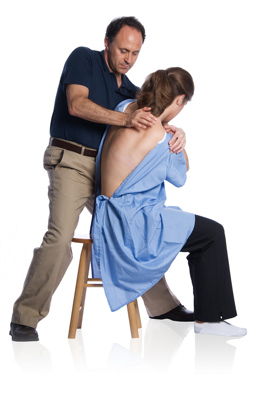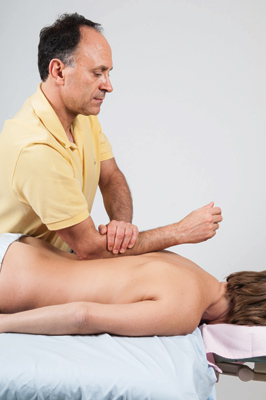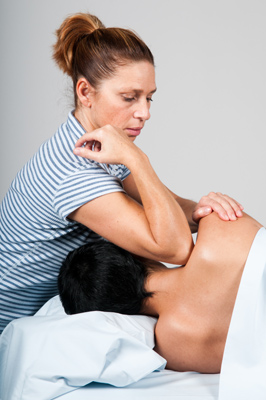 COURSE DESCRIPTION
COURSE DESCRIPTION
Clinical Orthopedic Manual Therapy (COMT) for the Thoracic Spine and Rib Cage covers the major clinical orthopedic assessment and treatment techniques for the thoracic spine and rib cage. This course is a 2-day hands-on workshop.
Day one begins with postural, orthopedic, and palpation assessment for the common neuromusculoskeletal conditions of the region, including upper crossed syndrome. We then cover body mechanics for deep pressure for working the thoracic spine and rib cage. With proper body mechanics, you will learn how the thoracic region can be worked deeply with little effort.
Day two covers stretching, including arthrofascial stretching (AFS) techniques. We begin with basic stretching for the functional muscle groups of the thoracic spine and shoulder girdle and then learn how to target each specific muscle with multiplane stretching. We then cover advanced neural inhibition stretching techniques, including Contract Relax (PNF/PIR), Agonist Contract (the basis for AIS), and Contract Relax Agonist Contract stretching techniques. Day two concludes with AFS (soft tissue Grade IV joint mobilization for manual therapists), including traction, for the thoracic spine and rib cage. AFS is the only effective means of stretching specific hypomobilities.
Clinical treatment strategy as well as precautions and contraindications are also covered. These manual therapy skills will empower you to do effective clinical orthopedic work. Throughout this hands-on workshop, Dr. Joe Muscolino reinforces the underlying mechanisms for each of the assessment and treatment techniques, encouraging critical reasoning skills.
Clinical Orthopedic Manual Therapy for the Thoracic Spine and Rib Cage is part of the COMT Regional Approach Certification. The other hands-on workshops in this series cover the neck, low back / pelvis, upper extremity, and lower extremity.
COURSE OBJECTIVES
 After attending this workshop, the participant will be able to:
After attending this workshop, the participant will be able to:
Explain and demonstrate the principles of using core body weight and larger muscle groups for efficient body mechanics.
Perform postural, orthopedic, and palpation assessment tests for the thoracic spine and rib cage to determine the ability to safely perform deep pressure massage, stretching, and arthrofascial stretching (Grade IV joint mobilization).
Explain the fundamental concepts of stretching and apply these concepts to the musculature of the thoracic spine and rib cage.
Demonstrate how to stretch each of the functional muscle groups of the thoracic spine and rib cage.
Explain and demonstrate how to stretch each of the muscles of the thoracic region and rib cage in multiple cardinal planes.
Explain the physiologic basis for and demonstrate how to perform contract relax (CR; also known as PIR/PNF) stretching, agonist contract (AC) stretching, and contract relax agonist contract (CRAC) stretching techniques.
Explain the physiologic basis for and demonstrate how to perform AFS of the thoracic spine and rib cage.
DETAILED TIME LINE
Following is the usual time line for this workshop. Note: This time line is often adjusted as needed based on the needs of the particular group.
DAY ONE:
Introductions: 15 min
- Introduction to the content of the class
- Introduction of instructor and workshop participants to each other
Postural, orthopedic, and palpation assessment of the thoracic spine and rib cage: 120 min
- Postural assessment for upper cross syndrome, hypokyphosis, and scoliosis
- Orthopedic assessment for thoracic outlet syndrome
- Palpation assessment
 Break: 15 min
Break: 15 min
Body mechanics and prone thoracic work: 60 min
- Work laminar groove musculature
- Orient core in line with stroke
- Keep elbow in
- Stack joints
- Work perpendicular to contour of client’s/patient’s body
- Maintain angle of elbow joint
- Lean in with body weight / core
- Brace contact
Body mechanics & shoulder girdle work: 45 min
- Table must be low
- Passively retract scapula and work deep to scapula
- Work cross-table
Lunch: 60 min
Body mechanics & side-lying and supine thoracic/pectoral work: 45 min
- Table must be low
- Access between ribs, serratus anterior, and subscapularis
- Work pectoral region
- Use body weight
Basic stretching (concept and body mechanics): 75 min
- Stretching is a mechanical protocol for making a soft tissue longer
- For a muscle, it involves passively bringing the client’s/patient’s muscle into a position that is the opposite of its action(s)
- Concept of stabilization: how to figure out how to stabilize
- Introduce concept of functional groups of muscles (trunk flexors, extensors, right lateral flexors, left lateral flexors, right rotators, left rotators; scapular protractors and retractors, elevators and depressors, upward and downward rotators)
- Incorporate body mechanics with elbow joint in, stacked joints, and using the core
- Workshop functional groups
Break: 15 min
Multiplane stretching: 75 min
- Begin with functional groups and narrow the scope to be able to target a specific muscle within the functional group
- All planes of motion (i.e., all joint actions) must be considered to optimally stretch a muscle: examples: right upper trapezius, pectoralis minor, etc.
Review: 15 min
- Question and answer
- Discuss treatment strategy
DAY TWO:
Introductions: 15 min
- Question and answer over material from Day 1
Contract Relax (CR) stretching: 60 min
- Principle of Golgi tendon organ reflex
- Demonstrate CR protocol for pectoral musculature
- Workshop CR technique for the major functional groups
- Workshop CR for specific target muscles
Agonist Contract (AC) stretching: 60 min
- Principle of reciprocal inhibition reflex
- Demonstrate AC protocol for pectoral musculature
- Workshop AC technique for the major functional groups
- Workshop AC for specific target muscles
Break: 15 min
CRAC stretching: 60 min
- Demonstrate CRAC protocol for the pectoral musculature
- Workshop CRAC technique for a few of the major functional groups
- Workshop CRAC for specific target muscles
Overview of AFS: 30 min
- Explain concept of pinning a bone and moving adjacent bone relative to it
- Client/Patient contact
- Therapist contact: index finger pads, thumb pad, pisiform or thenar eminence
- Steps: 1) Place pin. 2) Bring joint to tension. 3) Mobilize.
- Hold for less than a second, 3-5 oscillations
- Soft tissue pull to trap underlying bone
- Contraindications…
- Use hands in concert
- Utilize body mechanics
Lunch: 60 min
AFS prone: 60 min
- Posterior to anterior (extension)
- Transverse process contact
- Rib contact
AFS seated: 60 min
- Motion palpation assessment technique
- Joint mobilization for rib cage and spine
- The Saw
- Thai move with feet
Break: 15 min
AFS – supine: 90 min
- Workshop joint mobilization technique with the client/patient supine
- Rib contact
- Spinous process contact
Review and paperwork: 15 min
- Question and answer
- Fill out evaluation forms
- Hand out Certificates
WORKSHOP PARTICIPANTS SHOULD BRING
1. Massage table with face cradle
2. Stool
3. Bolster and pillow
4. Sheets and face cradle cover
5. Water-based lotion
6. Soft foam cushion (approx. 6×10 inches) or bath towel
7. Participants should wear a button down shirt that can be worn backwards for access to the back
Copyright 2014 © The Art and Science of Kinesiology – Dr. Joseph E. Muscolino
